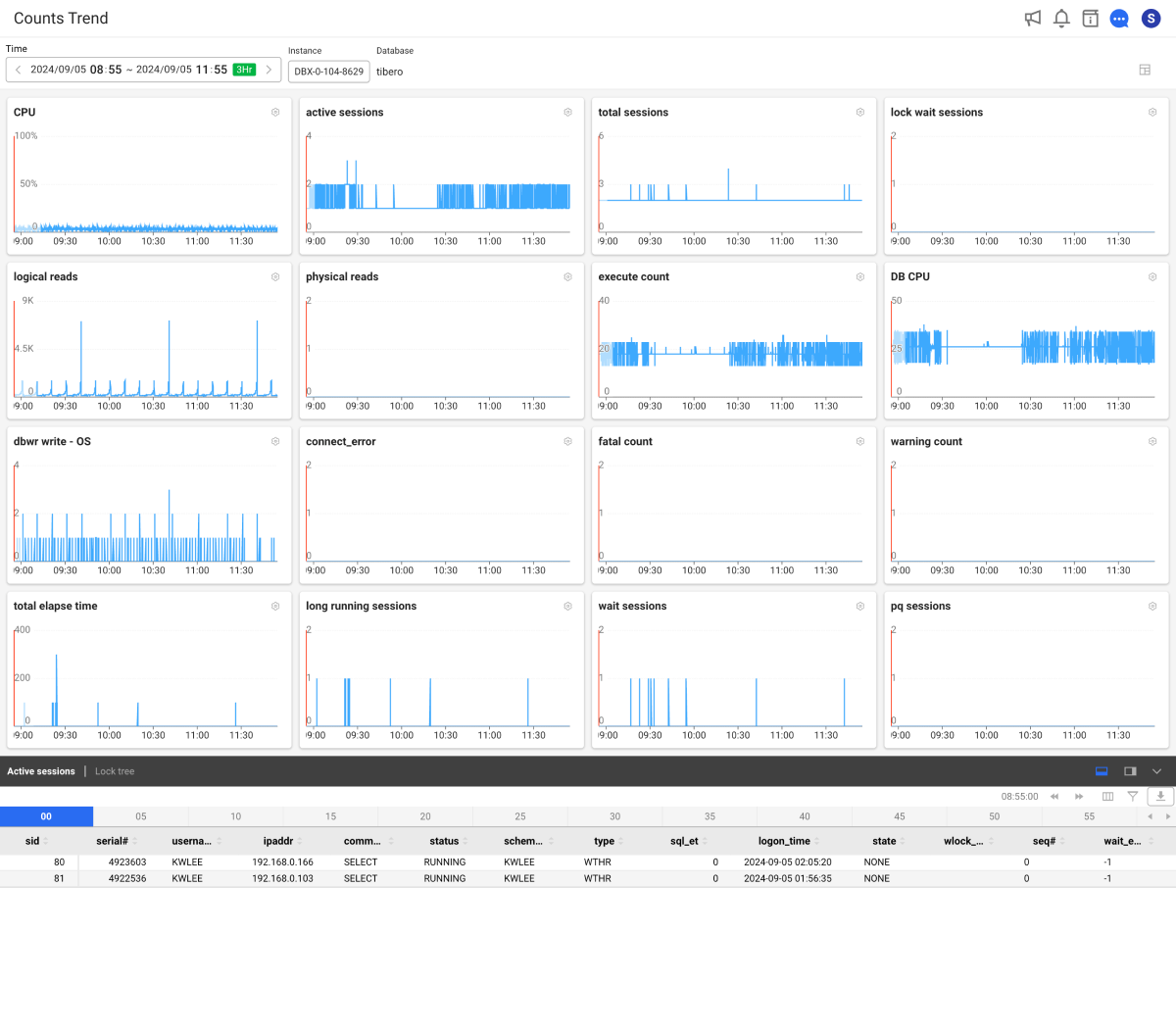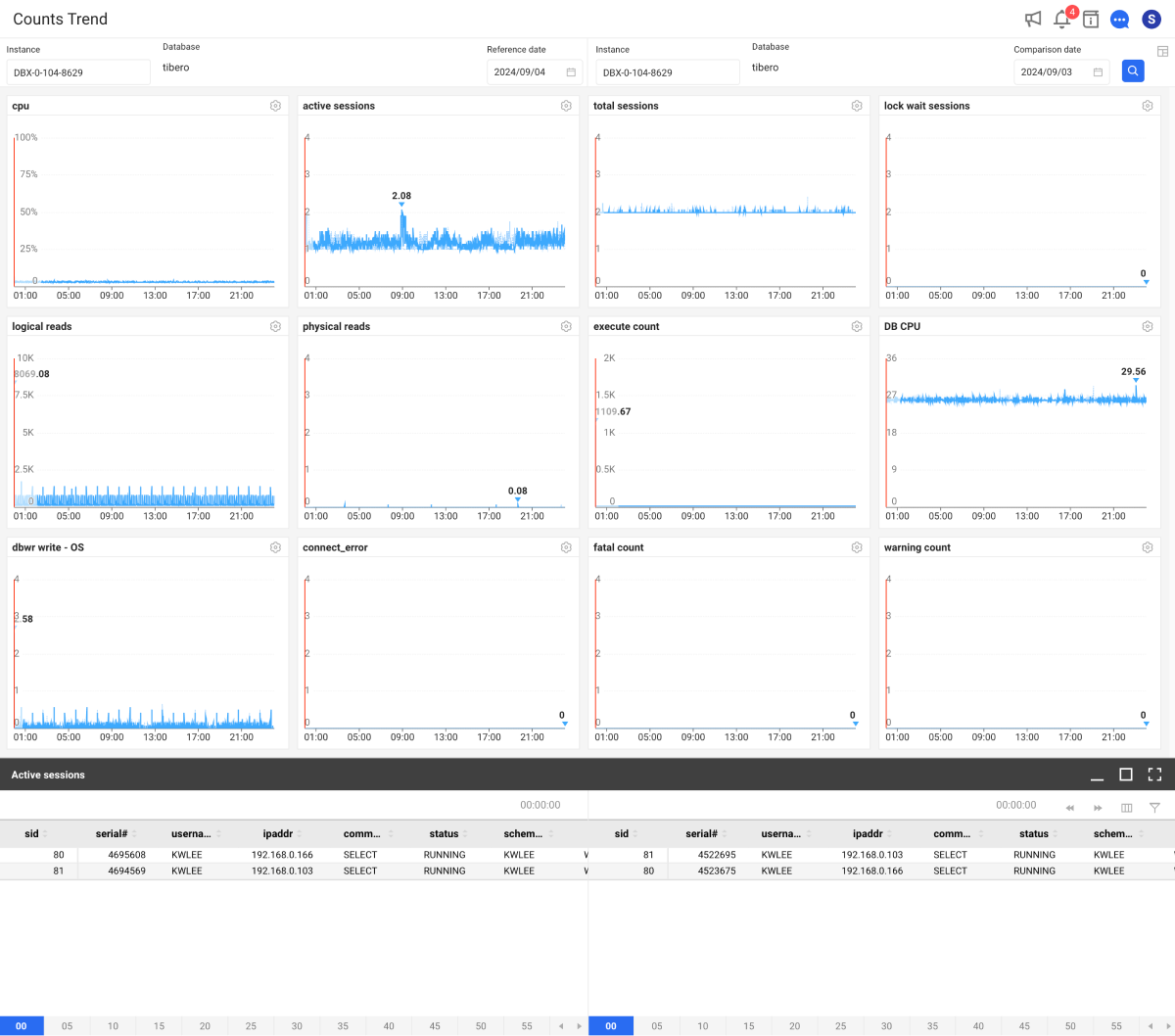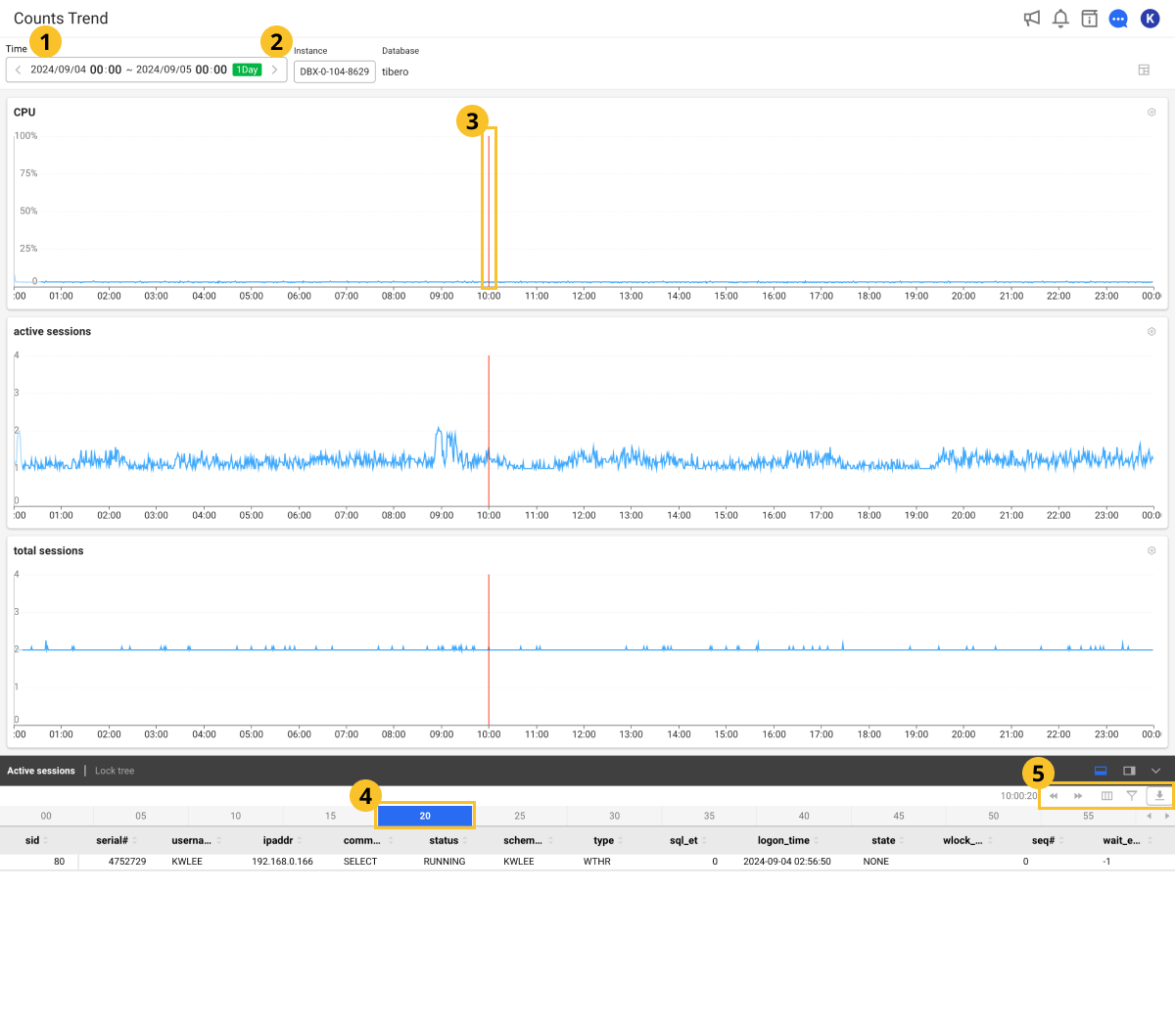Count trend and comparison
Counts Trend
Home > Select Project > Analysis > Counts Trend
You can check the operation trend of the key metrics of the database over time and trace the performance. You can check the current active session data and distinguish the long-running sessions.

Comparison between count trends
Home > Select Project > Analysis > Counts Trend Comparison

You can compare the count trends for different dates.
-
Select the desired instances from the Instance area. You can also select different instances.
-
Set values for Reference Date and Comparison Date.
-
Select
.
Using the chart and active session area
Select on the screen. In the Layout setting window, set it to 1 x 3 and then select Save. Time must be set to Last 24 hours. You can see the database key metrics in detail for the day, as follows:

-
In
Time, set a desired time interval.
- Click the green icon to select a search time.
- With the lookup period selected, select
or
. Then you can change the lookup time at the set time intervals.
- If you select the date and time, you can set the desired time in detail. After configuration, select Confirm.
-
Instance: You can select an instance that is connected with the project.
-
If you click a specific time point of the metrics chart, the (number3) area appears with red lines and the collected active sessions can be also displayed.
-
To change the metrics in the chart, select
on the upper right.
-
The active session data is collected every 5 seconds. You can search the data by selecting the
5-second cells at the bottom of the screen.
-
To move the time by 1 minute, select
or
.
-
: The column header entries in the table can be displayed or hidden.
-
: You can filter the list based on the column header entries in the table. After selecting the button, you can set the conditions in each header column such as Includes, Excludes, Equal, and Unequal.
-
: You can download the content of the table as a CSV file.
Column information guide
For more information about columns, see the link.
- Active session
- Lock tree
- Process information
| Item | Description |
|---|---|
action | Name of the running job. |
block_updates | Number of block updates. |
block_updates_sigma | Total number of block updates. |
client_identifier | Client ID. |
client_info | Additional information of the client. |
client_pid | PID of the client process. |
command | Command running in the current session. |
consumed_cpu_time | CPU time consumed by the session. |
consumer_group | Consumer group to which the session belongs. |
cpu(xos) | CPU utilization |
cpuusage | CPU usage consumed by the session. |
event_name | Name of the waiting event. |
execute_count | Number of SQL executions. |
execute_count_sigma | Total number of executions. |
id1 | First identifier value. |
id2 | Second identifier value. |
ioread(xos) | Actual time spent reading the block (milliseconds). |
iowrite(xos) | Actual time spent writing the block (milliseconds) |
ipaddr | Client IP address. |
logon_time | Time when the session logged in the database. |
logical_reads | Number of logical read operations. |
logical_reads_sigma | Total number of logical read operations. |
machine | Name of the machine on which the session is running. |
module | Name of the running module. |
os_thr_id | Thread ID of the operating system. |
osuser | User of the operating system running the session. |
parse_count_hard | Number of hard parses. |
parse_count_hard_sigma | Total number of hard parses. |
parse_count_total | Total number of parses. |
parse_count_total_sigma | Total number of parses. |
pdml_enabled | Whether parallel DML is enabled or not. |
pdml_status | Status of the parallel DML. |
pddl_status | Status of the parallel DDL. |
pga_used_mem | Amount of memory being used in the process global area (PGA). |
physical_reads | Number of physical read operations. |
physical_reads_sigma | Total number of physical read operations. |
pid | PID of the database process. |
pq_status | Status of the parallel query. |
prev_sql | Text of the previously executed SQL statement. |
prev_sql_id | Unique ID of the previously executed SQL statement. |
prev_sql_param | Parameter of the previously executed SQL. |
prog_name | Name of the program running the session. |
pss(xos) | Process specific memory usage + Percentage of shared memory occupied by one process. |
row_wait_block_no | Block number of the waiting row. |
row_wait_file_no | File number of the waiting row. |
row_wait_obj_id | Object ID of the waiting row. |
row_wait_row_no | Row number of the waiting row. |
rss(xos) | Resident Set Size (RSS) that is the number of physical pages associated with the process. |
schemaname | Name of the schema the session is using. |
seq# | Value indicating the sequence number of the session. |
sid | Session ID that uniquely identifies the session. |
sql_et | SQL execution time. |
sql_hash | Hash value of the SQL statement. |
sql_id | Unique ID of the SQL statement being executed. |
sql_param | Parameters used to execute SQL. |
sql_text | Text of the SQL statement being executed. |
sql_trace | Whether to trace SQL. |
state | Current state of the session. |
status | Status of the session. |
terminal | Name of the terminal to which the session is connected. |
type | Type of the session. |
usn | Undo segment number. |
used_blk | Number of used blocks. |
used_rec | Number of used records. |
wait_event | Event that the session is waiting for. |
wait_time | Waiting time. |
wlock_wait | Whether the session is waiting for a lock or not. |
wthr_id | Thread ID of the session's work. |
| Item | Description |
|---|---|
event | Name of the waiting event. |
holder type | Type of the session that owns a lock. |
id1 | First identifier value. |
id2 | Second identifier value. |
lock mode | Lock mode requested or owned by the current session. |
lock request | Status of the lock requested by the session. |
module | Name of the running module. |
pid | PID of the database process. |
prev_sql_id | Unique ID of the previously executed SQL statement. |
prev_sql_param | Parameter of the previously executed SQL. |
prev_sql_text | Text of the previously executed SQL statement. |
prog_name | Name of the program running the session. |
serial# | Serial number that distinguishes repeated attempts for the same session. |
sid | Session ID that uniquely identifies the session. |
sql_et | SQL execution time. |
sql_id | Unique ID of the SQL statement being executed. |
sql_param | Parameters used to execute SQL. |
sql_text | Text of the SQL statement being executed. |
status | Status of the session. |
username | Name of the user running the session. |
waiter type | Type of the session waiting for a lock. |
The following items are the metrics collected if the XOS agent has been installed.
| Item | Description |
|---|---|
cputime | CPU usage time |
cpuusage | CPU Utilization |
elapse | Elapsed time of CPU usage |
vsize | Virtual memory size (Kb) |
rss | Resident Set Size (RSS) that is the number of physical pages associated with the process. |
state | Process status |
ioread | Actual time spent reading the block (milliseconds) |
iowrite | Actual time spent writing the block (milliseconds) |
pss | Process specific memory usage + Percentage of shared memory occupied by one process |
uid | user id |
cmd | Executing command |
longcmd | Full path of cmd |
WhaTap basically stores the client-related information.